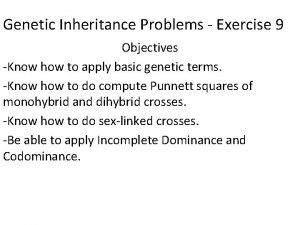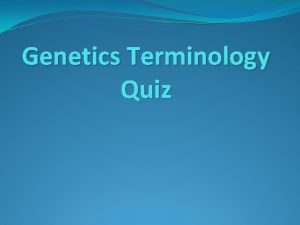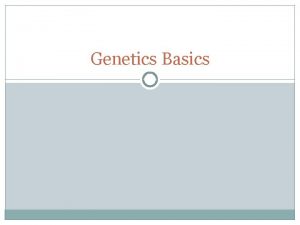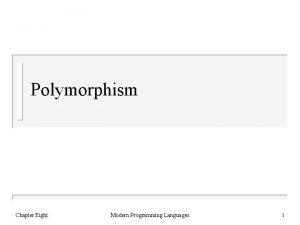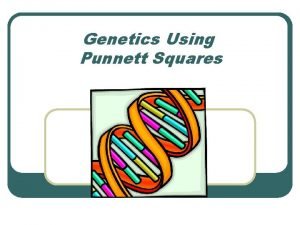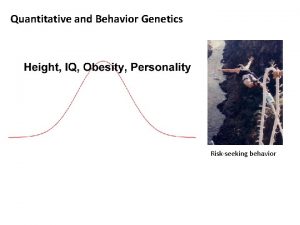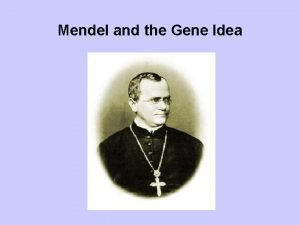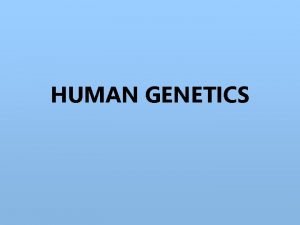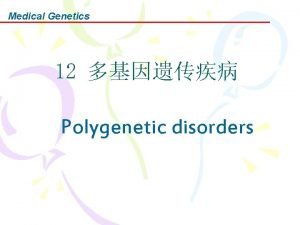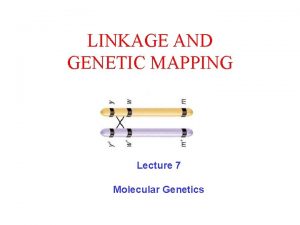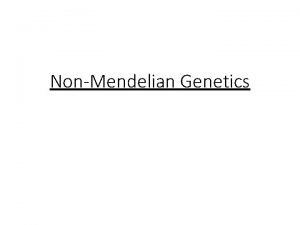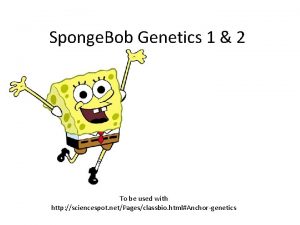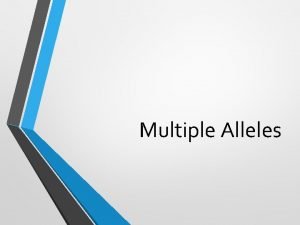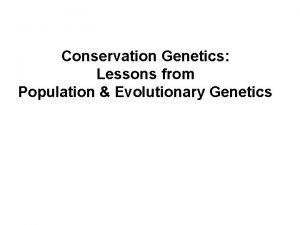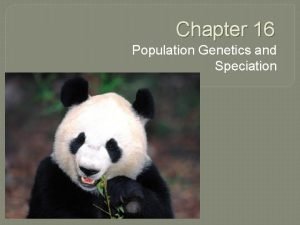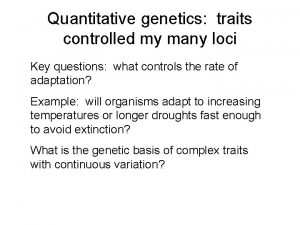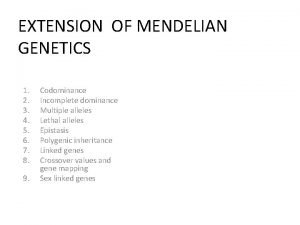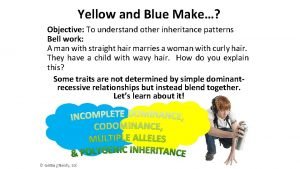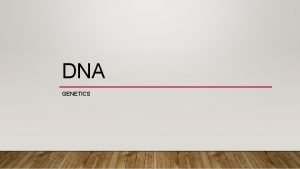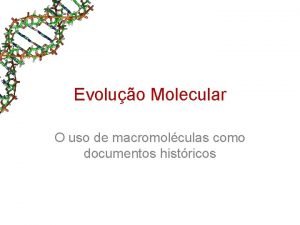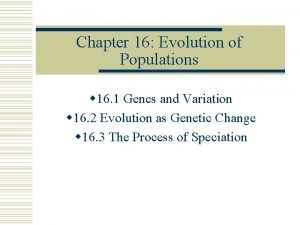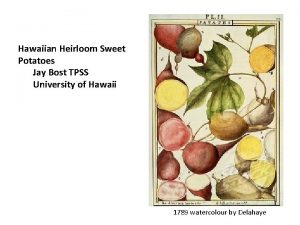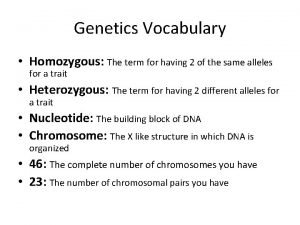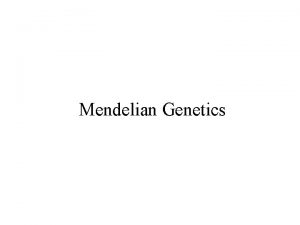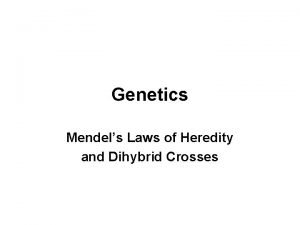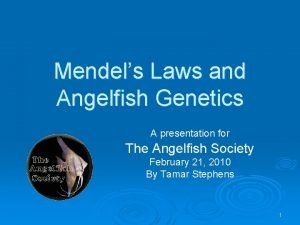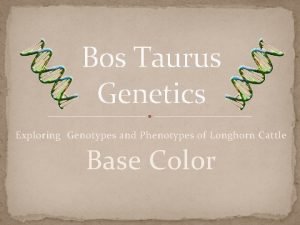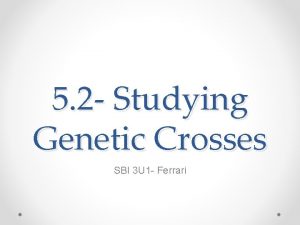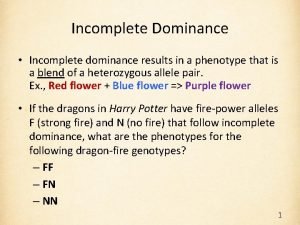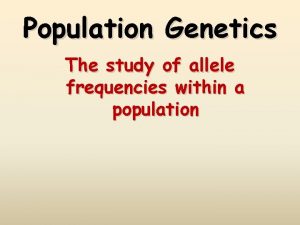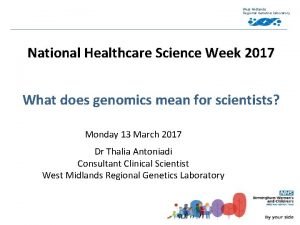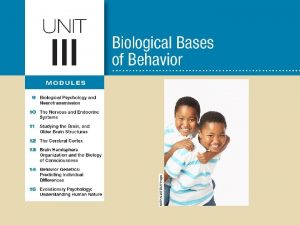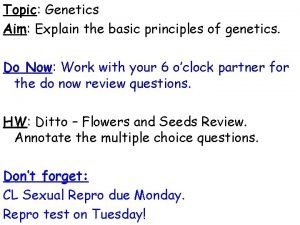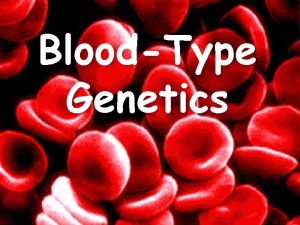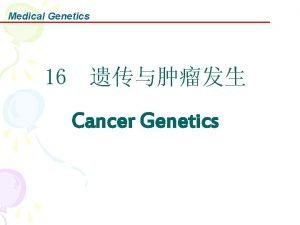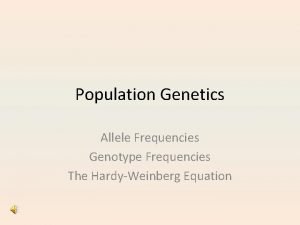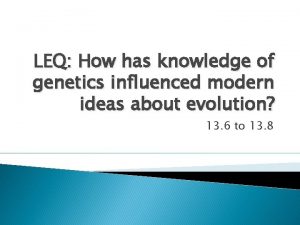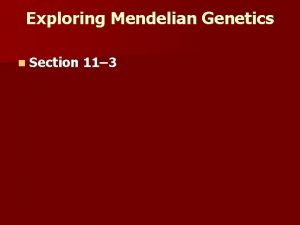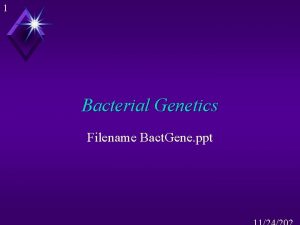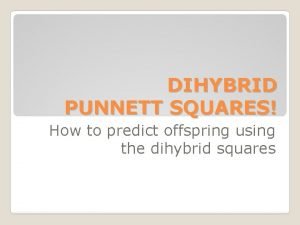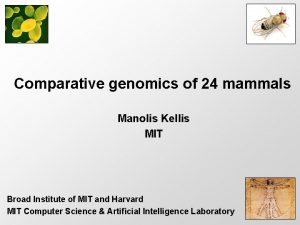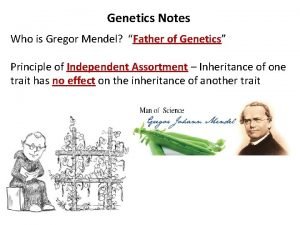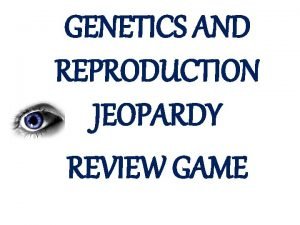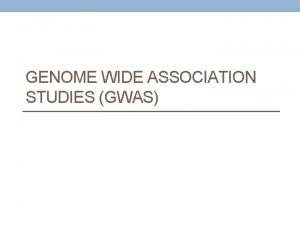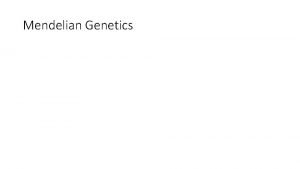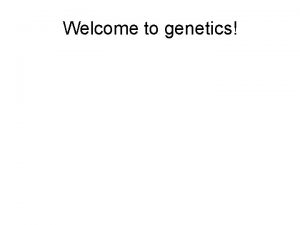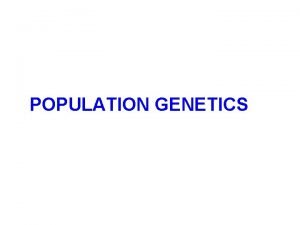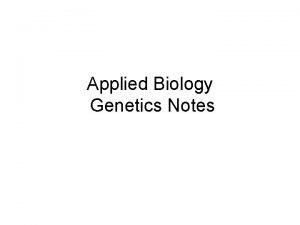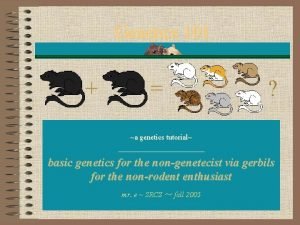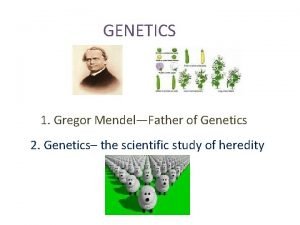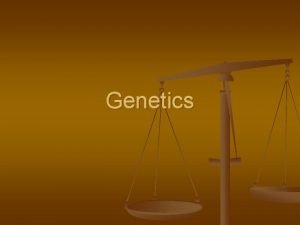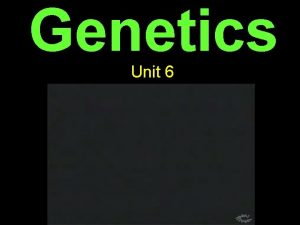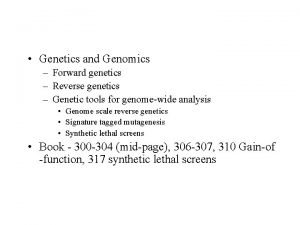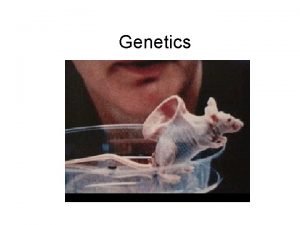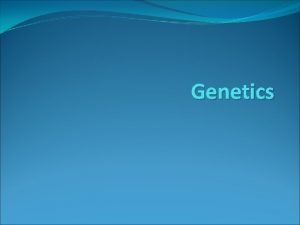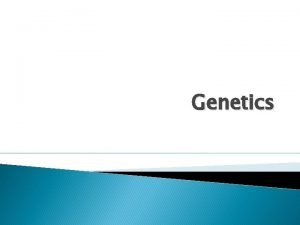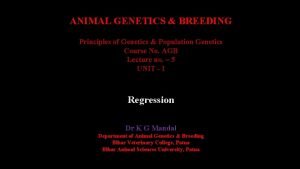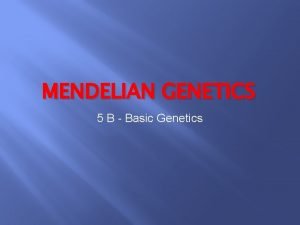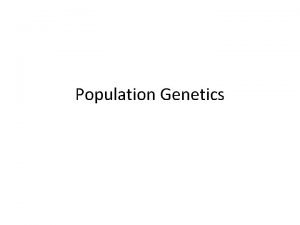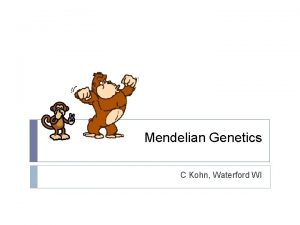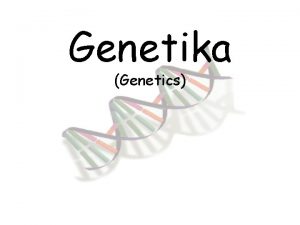Welcome to genetics What is genetics The scientific










































































































- Slides: 106

Welcome to genetics!

What is genetics? The scientific study of heredity - the genetic properties or inherited features of an organism • Molecular genetics: study of structure and function of DNA and RNA • Population genetics: study of genes within populations, including gene frequency, the gene pool and evolution

Like Begets Like

List differences in physical characteristics of you and your mother

Pre-Mendel Belief of inheritance: This theory stated that offspring would have traits intermediate between those of the parents (Blending Concept) Mendel’s Law of Segregation: Each organism contains two factors for each trait, and the factors segregate during the formation of gametes so that each gamete contains only one factor for each trait

Mendel in his garden Mendel observed over 7, 324 peas for one test cross

The history of genetics… • Meet Gregor Mendel. . . • Timeline of genetics I

Garden Pea Anatomy and Traits Easy to grow, short generation time, could control pollination, wide variety of traits

Mendel looked at 7 major traits Plant Height (tall, short) Pod color (green, yellow) Pod Shape (Inflated, constricted) Seed Shape (round, wrinkled) Seed Color (yellow, green) Flower color (white, purple) Flower position (side, top)

What Mendel didn’t know, was that genetic information is found on our chromosomes © 2007 Paul Billiet ODWS

Let’s learn about the relationship between chromosomes and genetics • http: //www. youtube. com/watch? v=e. Ov. MN OMRRm 8

CHROMOSOMES © The Human Genome Project: Biocomputing Admin Ed Yung

Eukaryotic Chromosomes • Found in the nucleus • Condensed and visible during cell division • At the beginning of mitosis they can be seen to consist of two threads (sister chromatids) joined by a centromere • The sister chromatids are identical copies • During mitosis the sister chromatids separate and are placed into two nuclei © 2007 Paul Billiet ODWS Image believed to be in the Public Domain

Numbers of chromosomes • Constant for each cell in the body (except sex cells which only have half sets). • Constant throughout the life of an individual (you don’t lose or gain chromosomes) • Constant for all members of a species © 2007 Paul Billiet ODWS

Human chromosomes Image believed to be in the Public Domain

The chromosomes of a human female © 2007 Paul Billiet ODWS Image believed to be in the Public Domain

Down’s syndrome Image believed to be in the Public Domain

Mouse Maize Image believed to be in the Public Domain © A. Lane Rayburn

Organism Human Chromosome numbers 46 Chimpanzee 48 House Mouse 40 Maize 20

Identifying chromosomes Chromosomes can be identified by: • Their size • Their shape (the position of the centromere) NB Chromosomes are flexible • Banding patterns produced by specific stains (Giemsa) Chromosomes are analysed by organising them into a KARYOTYPE © 2007 Paul Billiet ODWS © Biologyreference. com

Essential vocabulary of genetics: • Gene: A length of DNA that is the unit of heredity • Genotype: The genetic make-up of an organism, in terms of the allels present • Allele: Any of two or more alternative forms of a gene • Phenotype (trait): Physical or other features of an organism. Caused by combination of genotype AND environment

Homologous chromosomes:

Alleles

Each cell has (at least) 2 genes for any characteristic

Each cell has (at least) 2 genes for any characteristic Homozygous Homologous chromosomes have identical alleles of a particular gene. Two identical homozygous individuals that breed together will always have the same characteristics ‘Pure breeding’ Heterozygous: Chromosomes have two different alleles of a particular gene (Ff). • ‘not ‘’pure breeding’…

Dominant and recessive alleles • A dominant allele (e. g. F) will be expressed if it is present • A recessive allele (e. g. f) will only be expressed when there is no dominant allele of the gene present

Dominant and recessive genes A dominant gene (allele) is one that will be expressed physically if it is dominant A recessive allele (gene) is one that will only be expressed when there is no dominant allele of the gene present (e. g. t or g)

Cystic fibrosis is disease associated with expression of a recessive gene

Rules of ‘Mendelian’ Inheritance 1. Inherited traits are determined by genes that are passed from parents to children (Mendel’s Theory of particulate inheritance). 2. A child inherits two parent. 3. sets of genes—one from each A trait may not be observable, but its gene can be passed to the next generation

Mendelian Inheritance Each person has 2 copies of every gene—one copy from mom and a second copy from dad. These copies may come in different variations, known as alleles, that express different traits. For example, 2 alleles in the gene for freckles are inherited from mum and dad: – allele from mum = has freckles (F) – allele from dad = no freckles (f) – child has the inherited gene pair of alleles, Ff (F allele from mom and f allele from dad).

Genes, dominance and hybrids Mendel bred peas with contrasting physical characteristics and compared their offspring. • Each original pair of chromosomes are termed the P(parental) generation. • The offspring are called the F 1 (filial) generation (filius/ filia – son/daughter) • Offspring of parents with different traits are called hybrids (F 1 hybrids)

Testing inheritance: The F 1 cross… • To test for recessive genes, Mendel allowed all 7 kinds of F 1 hybrid plants to produce a second (F 2, second filial) generation by self-pollination • He crossed the F 1 generation with itself to produce the F 2 offspring • Roughly 25% of the F 2 plants demonstrated the recessive allele!

What type of cross did Mendel perform when he needed to determine the geneotype of an organism?


Definitions Autosome: any chromosome that is NOT a sex chromosome

Homework for Tuesday… Play the Dragon Game. . . Research about a type of genetically inherited disease: Find out about a type of inherited disease

Genetic Diseases

Autosomal Dominant Disorders Neurofibromatosis Huntington’s Disease

Autosomal Recessive Disorders Tay Sachs Cystic Fibrosis

Inherited diseases • • Phenylketonuria Sickle Cell disease Huntingdon’s disease Cystic fibrosis

Inherited diseases

Simple inheritance • ‘Single gene inheritance’ • ‘mono-hybrid cross’ • How Mendel worked (1) • How Mendel worked (2)

Law of Probability What are the chances of tossing two heads in a row? Five heads in a row? How about having two red heads in a row? Mendel’s Work All of these produce approximately a 3: 1 ratio.

Testing inheritance: The F 1 cross… • To test for recessive genes, Mendel allowed all 7 kinds of F 1 hybrid plants to produce a second (F 2, second filial) generation by self-pollination • He crossed the F 1 generation with itself to produce the F 2 offspring • Roughly 25% of the F 2 plants demonstrated the recessive allele!

One-Trait Inheritance Monohybrid cross

Working out inheritance: The Punnett Square…

Let’s meet Reginald Punnett… The rules of genetic inheritance. . .


Probability - likeliness that something will or will not happen Hey, Keith, how's the weather? Weather forecast (90% chance of rain) Winning lottery (1 in 2 million chance ) Well, there is a 50% chance of a snow.

Probability is used in genetics to predict what offspring will look like when 2 parents are crossed. X You can figure out the probability of getting a liger or a tigon.


A tool that can help you understand the laws of probability and how it is related to genetics is called a Punnett square, which is a chart that shows all the possible combinations of alleles that can result from a genetic cross.

Steps in Making a Punnett Square: 1. Draw a square and divide it into four. 2. The alleles for one parent go on the top. The alleles for the other parent go down the side. 3. The boxes are like a multiplication problem, with one allele contributed by each parent. I can only give 1/2 of my DNA to my offspring, so I will either give my baby plant a T OR a t. Tt

One Trait Inheritance • T = tall, t = short • Complete the punnet square in your notes. • Label the P gametes • Label the F 1 generation • What is the phenotypic ratio? • What is the geneotypic ratio?

One Trait Inheritance P gametes F 1 generation Phenotypic Ratio = 3: 1 Genotypic Ratio = 1: 2: 1 TT Tt Tt tt

Punnett squares are written like multiplication tables. X 1 2 3 4

Cystic fibrosis Punnet Squares (1)

Cystic fibrosis Punnet Squares (2)

Practice Questions on simple inheritance

1.

2. Jack and Jill are having a baby. What is the probability that their baby will be a BOY (XY)? What is the probability that their baby will be a GIRL (XX)? Jill - XX Jack - XY probability of having a baby girl (XX): _________ probability of having a baby boy (XY): __________

3. Use the Cats below to create a Punnett Square. Black = Dominant Blue/Grey = Recessive

d D Dd d Dd Dd Parent One Genotype ________ Parent Two Genotype ________ What % is Hybrid? _________ What % Homozygous? ________ What % are Black? __________ What % are Blue/Grey? ________

4.


5.


Working out inheritance What type of cross did Mendel perform when he needed to determine the genotype of an organism?

Testing inheritance: The F 1 cross… • To test for recessive genes, Mendel allowed all 7 kinds of F 1 hybrid plants to produce a second (F 2, second filial) generation by self-pollination • He crossed the F 1 generation with itself to produce the F 2 offspring • Roughly 25% of the F 2 plants demonstrated the recessive allele!


Taking Mendelian Genetics one stage further • The two factor cross • Mendel’s Law of Independent Assortment • Multiplication rule • Addition rule • Pedigree charts

Further genetics What happens if a number (say 2 or 3) traits are mixed? Di-hybrid and tri-hybrid crosses Mendel’s Law of independent assortment Multiplication rule for inheritance

Dihybrid Cross (Two-factor cross) • These involve TWO genes which control two different charaxteristics • Unlinked genes are found on different chromosomes • (autosomal) are those chromosomes which are not gender chromosomes • Dihybrind cross

Mendel’s Law of independent assortment • The principal of independent assortment states that genes for different traits can segregate independently during the formation of gametes (sperm and eggs). • Independent assortment helps to account for the many genetic variations observed in plants, animals and other organisms

Dihybrid Cross (Two-factor cross) • Step 1: Breed ‘true-breeding’ strains (F 1 generation) • Step 2: Breed the F 1 hybrids to produce the F 2 generation

Mendel’s Law of Assortment Each pair of alleles segregates independently.

2. A Dihybrid Cross

What about testing multiple genotypes? • Multiplication Rule: multiply the probability of one event with the probability of another event. Ex: coin toss heads = ½ coin toss tails = ½ ½ x ½ = ¼

Multiplication Rule • What is the probability of a cross between a Yy. Rr and a Yy. Rr producing a YYRR? Y y • The probability of YY = ¼ Y YY Yy y Yy yy • The probability of RR = ¼ Therefore ¼ x ¼ = 1/16 R r R RR Rr r Rr rr

A summary of Mendel’s Principles (1) 1. The inheritance of biological characteristics is determined by individual units – genes (alleles). Genes are passed from parents to their offspring 2. In cases where there are 2 or more forms of the gene for a single trait, some forms of the gene may be dominant and others may be recessive

A summary of Mendel’s Laws of inheritance (2) 3. In most sexually reproducing organisms, each adult has 2 copies of each gene – one from each parent. These genes are segregated from each other during meiosis 4. The alleles for different genes usually segregate independently

Using the multiplication rule for a trihybrid cross • You have freckles, dimples, and a widow's peak. Your S. O. has freckles and dimples, but a continuous hairline. In other words, • Ff. Dd. Ww x Ff. Ddww • Question: What is the chance your darling child would have all three recessive phenotypes: no freckles (ff), no dimples (dd) or a continuous hairline (ww)?

Pedigree Tables (1) • A ‘pedigree chart’ is a diagram of family relaitonships that can be used to determine the mode of inheritance of a trait • Introduction to pedigree tables

Pedigree Tables (2) • • • Male = square Female = circle Affected = dark Non-affected = light Carrier = half dark/ half light

Dd D D

Beyond Mendel • Incomplete dominance • Codominance • Polygenic traits • Multiple allelic traits • Genetic disorders • Testing for genetic disorders

Beyond Mendel Incomplete Dominance


Codominance • More than one dominant trait is present and both are expressed in their original form.

Multiple Allelic Traits More than two allelic forms are present in a population.

Pleiotropy • The ability of a single allele to have more than one distinguishable effect. For example the allele responsible for color pattern in Siamese cats.

http: //www. thecitychicken. com/mainpagemarch 24 -2011 c. jpg The Frizzle Effect In 1936, researchers Walter Landauer and Elizabeth Upham observed that chickens that expressed the dominant frizzle gene produced feathers that curled outward rather than lying flat against their bodies (Figure 2). However, this was not the only phenotypic effect of this gene — along with producing defective feathers, the frizzle gene caused the fowl to have abnormal body temperatures, higher metabolic and blood flow rates, and greater digestive capacity. Furthermore, chickens who had this allele also laid fewer eggs than their wild-type counterparts, further highlighting the pleiotropic nature of the frizzle gene . http: //www. nature. com/scitable/resource action=show. Full. Image. For. Topic&img. Src=/scitable/content/37535/ponch jpg

Pleiotropy in Humans • Marfan Syndrom • PKU

Polygenetic Traits The additive effect of two or more genes on a single phenotypic character (the opposite of pleiotropy).

Typical ‘Bell Curve’ for a polygenetic trait Some scientists suggest this accounts for behavioral traits Not completely predetermined, but associated with genes

High blood pressure is a polygenic trait. • What genes could combine to contribute to high blood pressure?

High blood pressure is a polygenic trait. • The phenotype is an interaction between a person's weight (one or more obesity genes), cholesterol level (one or more genes controlling metabolism), kidney function (salt transporter genes), smoking (a tendency to addiction), and probably lots of others too. Each of the contributing genes can also have multiple alleles.

Environmental Effect on Phenotype

Genetic Testing and Counseling • Diagnosis of carriers – Biochemical (i. e. Tay-Sachs) – Genetic (i. e. Huntington’s disease) – Ethical considerations • Fetal diagnosis- – Amniocentesis – Chorionic villi sampling


Chorionic villi sampling Chorionic villus sampling (CVS) is the removal of a small piece of tissue (chorionic villi) from the uterus during early pregnancy to screen the baby for genetic defects.

A son with cystic fibrosis (autosomal recessive) is born to a couple who appear to be normal. What are the chances that any child born to this couple will have cystic fibrosis? And the Answer is…. . 25%

In humans the allele for short fingers is dominant over that for long fingers. If a person with short fingers who had one parent with long fingers reproduces with a person having long fingers, what are the chances of each child having short fingers? And the Answer is…. . 50%

Homework: Complete the remain questions on the genetics problem set and do your genetics mini project.

Combining multiplication and addition rules to solve complex problems • An organism with the genotype Bb. DD is mated with one with the genotype BBDd. Assuming independent assortment of these two genes, what is the probability that you will get a BBDD offspring? • ¼ BBDD

More Incomplete Dominance Sickle Cell
 Scientific inquiry vs scientific method
Scientific inquiry vs scientific method How is a scientific law different from a scientific theory?
How is a scientific law different from a scientific theory? Wise men three clever are we
Wise men three clever are we Thiếu nhi thế giới liên hoan
Thiếu nhi thế giới liên hoan Chúa sống lại
Chúa sống lại điện thế nghỉ
điện thế nghỉ Phối cảnh
Phối cảnh Một số thể thơ truyền thống
Một số thể thơ truyền thống Hệ hô hấp
Hệ hô hấp Công thức tính độ biến thiên đông lượng
Công thức tính độ biến thiên đông lượng Số nguyên tố là số gì
Số nguyên tố là số gì đặc điểm cơ thể của người tối cổ
đặc điểm cơ thể của người tối cổ Tỉ lệ cơ thể trẻ em
Tỉ lệ cơ thể trẻ em Các châu lục và đại dương trên thế giới
Các châu lục và đại dương trên thế giới ưu thế lai là gì
ưu thế lai là gì Thẻ vin
Thẻ vin Các môn thể thao bắt đầu bằng tiếng chạy
Các môn thể thao bắt đầu bằng tiếng chạy Tư thế ngồi viết
Tư thế ngồi viết Cái miệng nó xinh thế
Cái miệng nó xinh thế Hình ảnh bộ gõ cơ thể búng tay
Hình ảnh bộ gõ cơ thể búng tay Cách giải mật thư tọa độ
Cách giải mật thư tọa độ Từ ngữ thể hiện lòng nhân hậu
Từ ngữ thể hiện lòng nhân hậu Tư thế ngồi viết
Tư thế ngồi viết Trời xanh đây là của chúng ta thể thơ
Trời xanh đây là của chúng ta thể thơ Thế nào là giọng cùng tên? *
Thế nào là giọng cùng tên? * Chó sói
Chó sói Thể thơ truyền thống
Thể thơ truyền thống Hổ sinh sản vào mùa nào
Hổ sinh sản vào mùa nào Thế nào là hệ số cao nhất
Thế nào là hệ số cao nhất Diễn thế sinh thái là
Diễn thế sinh thái là Vẽ hình chiếu vuông góc của vật thể sau
Vẽ hình chiếu vuông góc của vật thể sau Slidetodoc
Slidetodoc Phép trừ bù
Phép trừ bù Thế nào là mạng điện lắp đặt kiểu nổi
Thế nào là mạng điện lắp đặt kiểu nổi Lời thề hippocrates
Lời thề hippocrates Chụp phim tư thế worms-breton
Chụp phim tư thế worms-breton đại từ thay thế
đại từ thay thế Vẽ hình chiếu đứng bằng cạnh của vật thể
Vẽ hình chiếu đứng bằng cạnh của vật thể Quá trình desamine hóa có thể tạo ra
Quá trình desamine hóa có thể tạo ra Khi nào hổ con có thể sống độc lập
Khi nào hổ con có thể sống độc lập Các châu lục và đại dương trên thế giới
Các châu lục và đại dương trên thế giới Dot
Dot Nguyên nhân của sự mỏi cơ sinh 8
Nguyên nhân của sự mỏi cơ sinh 8 Bổ thể
Bổ thể độ dài liên kết
độ dài liên kết Spongebob genetics dihybrid
Spongebob genetics dihybrid The scientific study of heredity *
The scientific study of heredity * Basic terms in genetics
Basic terms in genetics Genetic terminology
Genetic terminology Rr x rr
Rr x rr What is genetic polymorphism
What is genetic polymorphism Nature genetics
Nature genetics Genetics
Genetics Genetics
Genetics Multiplication and addition rule genetics
Multiplication and addition rule genetics How many autosomes are there in a human sperm? *
How many autosomes are there in a human sperm? * Who is the father of genetics?
Who is the father of genetics? Genetics
Genetics Recombination frequency
Recombination frequency Codominance
Codominance What is the punnet square
What is the punnet square Sponge bob genetics
Sponge bob genetics Foil method in dihybrid cross
Foil method in dihybrid cross Ao+ blood type
Ao+ blood type Evolutionary genetics
Evolutionary genetics Nature genetics
Nature genetics Gregor mendel’s principles of genetics apply to
Gregor mendel’s principles of genetics apply to Population genetics and speciation worksheet answer key
Population genetics and speciation worksheet answer key Phenotypic variance
Phenotypic variance X linked recessive punnett square
X linked recessive punnett square Unit 5
Unit 5 Chapter 12 section 1 molecular genetics answer key
Chapter 12 section 1 molecular genetics answer key Extension of mendelian genetics
Extension of mendelian genetics Genetics yellow and blue make answer key
Genetics yellow and blue make answer key Genetics
Genetics Population genetics
Population genetics Genes is the study of heredity and variation
Genes is the study of heredity and variation Arvore filogenetica
Arvore filogenetica Population genetics
Population genetics Section 14-3 human molecular genetics answers
Section 14-3 human molecular genetics answers Hawaiian heirloom genetics
Hawaiian heirloom genetics Heterozygous example
Heterozygous example Monohybrid cross definition biology
Monohybrid cross definition biology Marfan syndrome genetics
Marfan syndrome genetics Rednwings
Rednwings Reindeer genetics dihybrid crosses
Reindeer genetics dihybrid crosses Angelfish genetics
Angelfish genetics Taurus genetics
Taurus genetics Sbi3u genetics test
Sbi3u genetics test Harry potter genetics incomplete dominance answer key
Harry potter genetics incomplete dominance answer key Artificial speciation
Artificial speciation West midlands regional genetics laboratory
West midlands regional genetics laboratory Module 14 behavior genetics
Module 14 behavior genetics Blue eyes dominant or recessive
Blue eyes dominant or recessive Blood type inheritence
Blood type inheritence Genetics
Genetics Gene frequency
Gene frequency Genetics
Genetics Section 11-3 exploring mendelian genetics
Section 11-3 exploring mendelian genetics Bacterial genetics ppt
Bacterial genetics ppt Foil punnett squares
Foil punnett squares Nature genetics
Nature genetics Sexual reproduction and genetics section 1 meiosis
Sexual reproduction and genetics section 1 meiosis Chapter 12 section 1 dna the genetic material
Chapter 12 section 1 dna the genetic material Genotypic ratio
Genotypic ratio Genetics jeopardy review game
Genetics jeopardy review game Gwas
Gwas















































